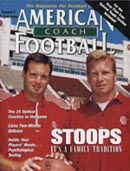Article CategoriesAFM Magazine
|
2 Minute Defenseby: Larry Peccatiello,Defensive Coordinator, Detroit Lions © More from this issue We have all heard TV analysts saying "Prevent defense. What does it prevent?" To an extent, this question seems to have some validity. However, defensive coaches must have the necessary "ammo" to make a variety of calls with regards to score, time remaining and time outs. Having the flexibility to use a three- or four-man line gives you an advantage in the two minute, no-huddle situation. Our "rover" package gives us a chance to play both a three- or four-man line within the context of one defense. This personnel grouping consists of three defensive linemen, six defensive backs, one linebacker, and the "rover." The player who is the rover must be capable of being a linebacker or a fourth defensive lineman. Before examing this concept in more detail, here are several important factors both players and coaches must consider: 1. Know the rules! Know what stops the clock and when it starts back up again. (For instance, there are times when the ball is put into play at the snap, and other times the ball is put into play on the referee's whistle.) 2. Everyone on the entire defense should know the defensive signals to combat the no-huddle offense. We will give a wrist band list of calls to our defensive signal callers. This way, they can just work from a numbered list of calls when the coach flashes a number. All of this speeds up the signal system. 3. Substitute your defensive line liberally when and if the clock stops. The no-huddle totally wears these players out. Keep the d-line fresh. 4. In most situations, don't enter into two-minute mode until the clock gets to 60 seconds or less. Before that, play the defense you have been playing all day. Do not lose your aggressiveness. 5. Emphasize poise, both on the sideline and on the field. Avoid confusing substitutions and signals. If the sideline is chaotic, the players on the field will respond in a similar fashion. 6. Study film. Know how the quarterback sets and readies the team. Many times the ball will be snapped on the first sound, or possibly a hand signal. Often audibles for draws and screens can be easily detected. 7. Be prepared to anticipate either draws or screens on an early down. Most often teams will start with a conservative clock play to test the water. The Rover Defense When we use our rover as the fourth defensive lineman, we are simply playing a dime defense. The dime concept allows us to play all of our calls that we would normally use during the course of the entire game. This includes all of the variety of coverages and blitzes we have in our game plan. Do not be foolish, however. Keep the pressure on and mix the coverages. Try and play coverages that keep the ball inside and deny the outside play that stops the clock. Some examples: Note: With the "dime strong zone" coverage, the nickel and strong corner can exchange assignments: i.e., the strong corner can play the flat and the nickel can play the deep outside third - kick call. However, if a third receiver is to that side, they would not make this adjustment.Rover Package Use line stunts when rushing only three players. If you use a straight rush, power rush the offensive tackles. With a three-man line you can be very creative. Let your imagination run wild. Rush three and cover, or use either the dime, nickel, rover or backer as your fourth rusher. Then simply adjust all of your dime package coverages. (You should attempt to collapse the pocket and not give the QB throwing lanes.) With the three-man front you can: rush four and continue to play dime coverages (see Diagram 6); rush five and play man-to-man with a free safety or a void (three deep and three under) zone (see Diagrams 7 & 8); or, cover with eight and rush three (see Diagrams 9 & 10). Last Play of the Game or Half This has been referred to as the "Big Ben" or "Hail Mary" play. Don't let this play be successful. Nothing can be more demoralizing than allowing this play to succeed (see Diagram 11).Important points: 1. Secondary play deep. Play the ball moving forward and not out of a back pedal. 2. Smash the ball downward - do not attempt to catch it. 3. Offset your line to the left or right to combat the roll out by the QB (left or right depending on the QB's throwing arm). 4. Pressure: you don't need all of your short defenders. 5. Designate your defenders into: smashers, front tip and back tip, pile driver - play the ball front to back into the pile, and gadget defenders. Remember, flexibility is the key to defending in this situations and may keep you from and your team from becoming one of those "what does it prevent?" statistics. |
|
| HOME |
MAGAZINE |
SUBSCRIBE | ONLINE COLUMNISTS | COACHING VIDEOS |
Copyright 2024, AmericanFootballMonthly.com
All Rights Reserved




